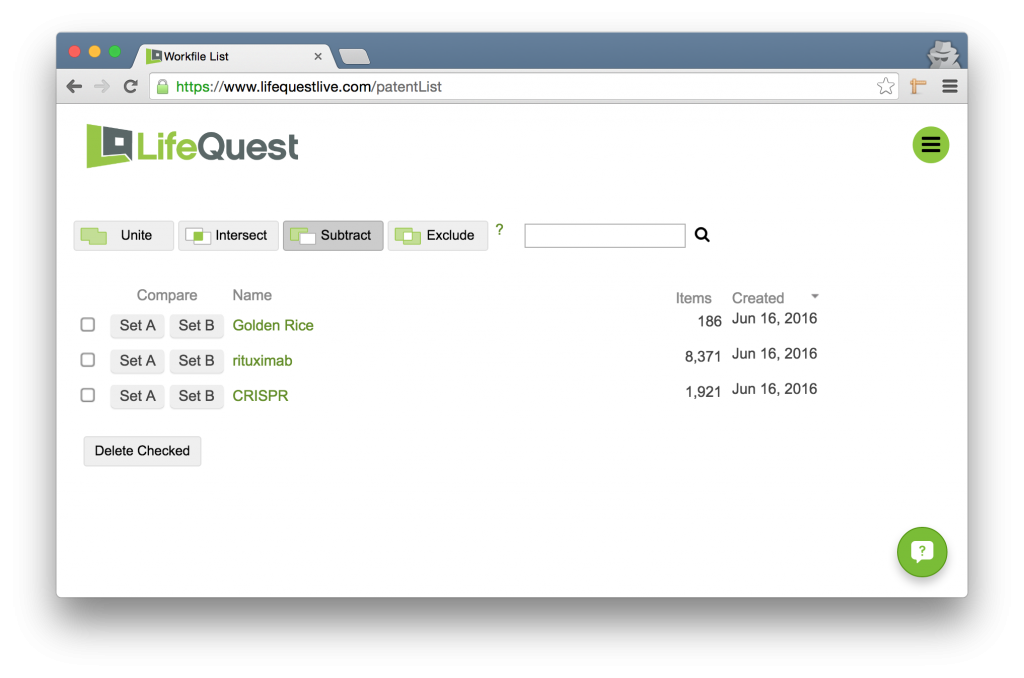- 5.1 The Workfile Management Page
- 5.1.1 Layout and Navigational Elements
- 5.1.2 Accessing the Page
- 5.2 Set Operations
- 5.3 Deleting Workfiles
5.1 The Workfile Management Page
The Workfile Management page allows you to interact with multiple workfiles at once. Primary use cases are:
- Find historical workfiles to explore them
- Merge multiple workfiles together
- Delete workfiles
5.1.1 Layout and Navigational Elements
The page consists of three main areas. At the top is a row of set operators. To the of these buttons you can search for workfiles by beginning to type in the search box area. The large section below the top row consists of the list of workfiles that you have created. This will be blank if you haven’t created any workfiles yet.
You can sort the list of workfiles by clicking on any of the headers: Compare, Name, Items, and Created. By clicking the same header twice you will sort the list by that column in reverse order.
Note that to the left of each workfile in the list is a checkbox and two buttons, Set A and Set B The checkbox is used to select workfiles for deletion. The Set buttons are used in set operations.

5.1.2 Accessing the Page
You can access this page either from the following places:
- The main search page has a link called See all just at the top of the Workfile list on that page.
- Use the Navigation Menu from any page and choose Manage Workfiles
5.2 Set Operations
You can combine any number of workfiles using traditional set operations. This is useful in a number of cases, for instance:
- You want to compare the similarities of two different workfiles
- You want to merge a sequence search result from GenomeQuest with a LifeQuest text workfile
- You maintain a list of patent documents in one workfile that you are very familiar with and want to remove them from new workfiles you create.
- You want to see the differences between two different workfiles.
- You want to see what has changed since the last time you looked at a workfile.
When combining workfiles, consider each of them as a set in the mathematical sense, where each element of the set is a single document within the workfile, identified by its publication number.
Workfiles produced by this method are given a default name which is the specific set operator used to create the new workfile followed by a unique date string. Example: intersect 20151231204749 is the default name of a workfile that was created by intersecting other workfiles on 12/31/2015. You can of course rename these workfiles in the Workfile Browser page simply by selecting the title in the top right and typing a new name.
5.2.1 Choosing Sets and Operators
All set operations are performed between a Set A and a Set B which you define by pressing the corresponding buttons on certain workfiles. For instance, in the below example, the user has defined Set A to be the workfile US Sequences This Year, and Set B as the combination (the union of) BRCA in abstract and FOLFIRINOX. It is with these two sets that one of the four set operations can now be performed.
5.2.1.1 Unite
The operator will merge the two workfiles, creating a new workfile that has all of the documents in Set A plus all of the documents in Set B.
5.2.1.2 Intersect
The operator will build a new workfile that has only those documents that are in both Set A and Set B.
5.2.1.3 Subtract
The operator will build a new workfile that removes all documents from Set A that are found in Set B.
5.2.1.4 Exclude
The joins Set A and Set B, but excludes and documents that are shared by both. Logically it is equivalent to Subtract(Unite(A,B),Intersect(A,B).
5.2.2 How Workfile Annotation is Preserved
In the case of the Unite and Intersect operations, the resulting workfile can contain documents that existed in both Set A and Set B. If these documents had been annotated previously, the following rules apply to determine which annotation is applied:
- star: the highest star value will be used
- color: the color with higher priority will prevail. The order from lowest to highest priority is: order from low to high: 0 1 2 3 4 5 6
- checkbox: checked if any of the checkbox is checked
- deleted: deleted if every item is marked deleted
5.3 Deleting Workfiles
To delete one or more workfiles, simply click the checkbox to the left of the workfile(s) and then click the button at the bottom left of the page. Note: this operation is not undoable.